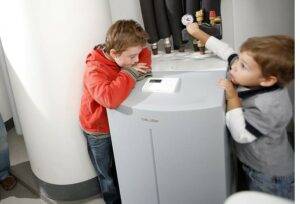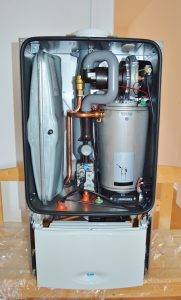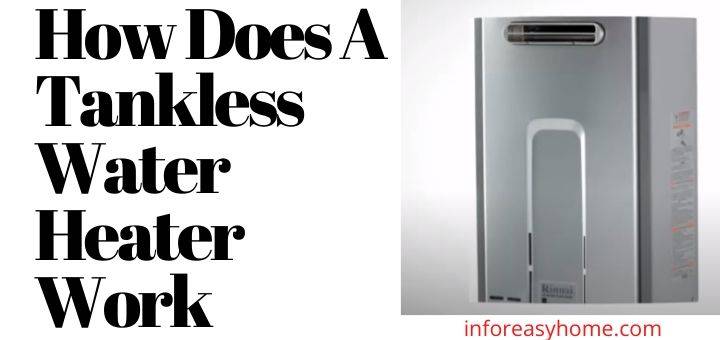Imagine you come home after a hard day’s work, and the only thing on your mind is taking a nice, long, hot shower. You hop in and start to enjoy the hot water splashing down at you.

However, just a couple of minutes into your bathroom, you notice the water temperature turning lukewarm. Another minute later, it is bordering on chilly. Before realizing it, your nice hot shower has become a freezing torture test.
How can this happen? Well, more than likely the problem can be traced to an underachieving storage-tank water heater.
For this reason (and others), more and more people are starting to discover the benefits of switching over to a tankless water heater. How does a tankless water heater work? In this article, we’ll give you the skinny in-depth operation of this amazing system.
Did you know that Water heaters have been in operation for nearly 150 years? They first started in London before a Norwegian further developed the idea in Pittsburg, Pennsylvania.
Initially, they were placed beneath water pipes, and the heated water was used for household purposes. Today Water heaters are conventional in many households.
Before we examine the tankless water heater, let’s take a closer look at its counterpart, the storage water heater.
A storage-tank water heater keeps a certain level of water hot 24 hours a day, which can lead to some negative results. First, this constant energy use leads to higher electricity bills and unnecessary wear on the water tank.
Besides, when the hot water supply gets used (as in the example above), the water tank needs a standard amount of time (also known as recovery time) to heat the water back up again. This can often be frustrating, especially in larger family homes where the battle for hot water can be “heated”.
That leads us to tankless water heaters. These systems are designed to heat water as you need it, which means that everyone in your family will be able to use hot water anytime on demand. How is this possible? Well, learn more about its working mechanism below.
How Electric Tankless Water Heater Works
Electric tankless water heaters work mostly on the principle of thermostatic control.
The principle behind thermostatic control in an electric tankless water heater is a series of ingeniously designed coils are instantly supplied with electric current which activates the water heater and the heater’s control board adjusts electric flow to the burner based on the incoming water temperature, the desired water temperature, and the difference between the two.
Whenever somebody turns the hot water faucet, the tankless water heater springs into action. Cold water flows into the heater and is instantly heated by copper and brass waterways known as exchangers as the sensor modulates the power output for the flow rate. The result is continuous hot water in a matter of seconds!
The hot water temperature will always remain the same, which should eliminate any incidences of burns or scalding water. When the tap is turned off, the heater shuts down and goes into standby mode until it is needed again.
This system is a lot more efficient than standard storage-tank water heaters.
This intelligent functioning means that you and your family can enjoy unlimited hot water.
This concept of heating water instantaneously has given tankless water heaters an edge over storage tank water heaters because, for now, instead of storing heated water throughout the day, cold water is heated whenever it’s on demand.
This, in turn, has resulted in a decrease in energy loss of up to 30%.
Let’s look at how these five different Electric Tankless water heaters work
Whole House Electric Tankless Water Heaters
A whole-house electric tankless water heater has an increased GPM flow rate which is capable of supplying a constant flow of hot water for all household needs due and as a result the capability to distribute simultaneously beyond a single fixture at one time. 
A whole house water heater can provide hot water, which equals four-point of use water heaters.
The heater is a box equipped with a heating mechanism, which starts working by merely bringing cold water through a system of pipes. The Coldwater will travel through the pipes and into the heater unit and then heat the water using the electric heating element inside the box and eventually supply your home with constant hot water.
Whole-house electric water heaters are low costs with high-efficiency water heaters. Before you settle for the ideal whole-house water heater, you got to determine the number of gallons per minute that is sufficient for all household needs. Consider also your geographical location to determine the average temperature rise of the water.
Single-Use Electric Tankless Water Heaters
Single-Use Electric Water Heaters Serve for point-of-use applications. POU tankless appliances are dedicated-use heating units and for this reason deliver warm water to a specific fixture at any time such as in bathrooms, sinks, or showers.
Single-use electric water heaters reduce energy loss by eliminating heat loss between the central water heater and the faucet. Water is heated very near the location of use instead of a central location, thereby improving energy efficiency by eliminating standby energy loss.
Most single-use electric water heaters are compact, measuring an average of 10 in x 13, therefore, sparing much space.
They are useful when considering an addition to hot water needs. Consider using a single-use water heater also if some fixtures are distant from other fixtures or if the daily use is less than 20 gallons.
Portable Electric Water Heaters
Portable electric water heaters are typically used for outdoor use. They are Very light with a lower flow rate and can be carried and installed anywhere either as wall mounting or self-standing.
They are mostly ideal for traveling and camping. You can take them on camping trips or a festival or just as an indoor additional water load.
By simply placing them near an electrical outlet or a car battery, the cold water runs through the heating element inside the tank, and it’s instantly heated, providing you the comfort of warm showers or warm water to wash dishes.
Outdoor Electric Tankless Water Heaters
Outdoor water heaters are majorly ideal for homes with not enough space; thereby, they get installed on the outside wall.
Due to the complicated conditions of outside weather, the outdoor tankless water heater is designed with freeze protection.
Why should you buy an electric tankless water heater?
Advantages of a Tankless Water Heater
Tankless water heaters last longer than tank water heaters. Aside from saving space effectively (most units are a quarter of the size of conventional heaters), tankless water heaters also provide unobstructed heat transfer.
Why is this? Because water isn’t stored in a tankless heater, mineral build-up doesn’t occur. This enables a tankless water heater to perform at an optimum level for upwards of 20 years or more.
These are the benefits of having electric tankless water heaters.
Environmental friendly
With the greenhouse movement of saving the planet from pollution, electric water heaters are better for ecological conservation. They have zero emissions, unlike gas water heaters.
Space saver
Tank water heating appliances have a reputation for being large and bulky. However, Tankless water heaters are compact by design, which saves a lot of space by quickly mounting on a wall. They blend in easily with wall décor, thereby no distraction to the general outlook.
Improved Energy Efficiency
According to the Department of Energy, homes that use 41 gallons of hot water or less daily are 24% – 34% more efficient.
Using a tankless heater can be beneficial in several different ways. First, they are much more energy efficient because they are on-demand water heaters and do not utilize energy to keep stored water hot for long periods.
They heat water only as it is demanded, which reduces the standby loss associated with letting it sit for long periods cutting down your monthly bill. This means you can expect lower energy costs.
You can use an energy guide sticker to determine how much cost of the power you have cut down every month
Virtually Endless Hot Water
Tankless water heaters can provide a constant supply of hot water.
As long as water demand is within your heater’s capacity, you’ll continue to receive hot water as long as your fixtures and appliances demand it. This means you’ll never run out.
Modular Point-of-Use Models
They are also available in “point of use” models, which are designed to heat water used in a specific area. Point-of-use tankless systems are perfect for home additions, guest houses, bathrooms, and other areas that suffer from ineffective hot water delivery or are unable to access gas or electric lines.
With the right tankless water heater, you can be guaranteed a good supply of hot water without worrying about it running out.
Now that you have a better idea about how a tankless water heater works, why not consider replacing your outdated storage tank with a system of your own?
Buying Guide for Tankless Water Heaters
Here are some things to consider before buying and installing a tankless hot for your home or business.
-
Power supplies with tankless water heater
Tankless water heaters are normally powered by electrical, gas, or propane. Different power types are designed for different uses.
For example, electric tankless water heaters have lower power efficiency however it is easier to be installed. On the other hand, Gas or propane-fueled tankless water heaters have better power efficiency but a more complex installation process.
-
Price
Consider; it affordable. For each category of Electric tankless water heaters, there are different products with varying costs. In terms of price hierarchy, the most affordable are outdoor water heaters.
-
Application of tankless water heater
When you are shopping for a tankless water heater, you will have to be aware that some of these heaters are for single-point applications and some with multiple-point applications. Single point application means you will only have one single outlet for hot water (your shower tap for example); while multiple points enable you to have more hot water outlets (for example, shower and basin taps).
-
Installation
Sizing and installation are the principal criteria for optimizing the energy efficiency of your tankless water heater. Can it be easily installed anywhere I want?
Since Homes with multiple residents may want to install more than one system, the inbound water supply will decide the size and amount of whole-house heating units for your home.
Installation is easier to complete during the building phase of a new home or office, although pre-existing buildings can be retrofitted.
Each category has different installation spots. It’s necessary to consider installing the water heater in dry and well-ventilated areas. Damp places will corrode the water heater. The installation area should be easily accessible to enable you to operate.
-
Efficiency
Consider; is energy-efficient and cost-efficient to run. Before using an electric water heater, the initial cost of installing the water heater runs higher than traditional tank water heaters.
Nevertheless, correctly gauged and skillfully set up instantaneous heating appliances will provide houses with long-term energy cutback and unconstrained warm water supply on demand.
The energy-saving of a tankless water heater will reduce the utility bill making them cost-efficient in the long run compared to their traditional tank water heaters.
-
Safety Measures
Consider; what safety measures it comes with. Tankless water heaters are safer because it does not store water that can be a breeding ground for bacteria such as Legionella. If the appropriate temperature is not maintained, they can thrive in your waters, especially if the temperature is between 20°C and 45°C.
Safety is a priority when buying, and when using the water heater
For safety measures
- Don’t put flammable matters on the machine. Placing the water heater near an inflammable can result in a serious explosion. The explosive might catch fire. This fire will cause electric shocks that might lead to a blast. It’s advisable to keep combustible materials further away as much as 20 inches from the water heater.
- Checking on the condition of the machine regularly is critical because the temperature and pressure valve poses a hazard. Without regular check-ups, the water heater might build up a lot of pressure, which could result in an explosion. To prevent this, the job of the pressure valve is to release excess heat and pressure. Please inspect the condition of the valve by lifting the valve and letting it snap back into place. The pressure valve will give off a bubbling sound. If it fails to give off that sound, then it’s an indication that you ought to get a replacement.
- Always follow the instructions laid out in the user manual.
-
Lifespan
Consider; does the water heater have a longer lifespan?
Electric tankless water heaters have a longer life expectancy than traditional water heaters. They usually last 10 to 15 years. On each product of an electric water heater, the manufactures label encodes the date of manufacture.
-
Saves space
A tankless water heater also saves space. No longer do you need room for a bulky 40 or 50-gallon tank.
Since the unit is tankless it is much smaller and compact it can fit into a wide variety of places throughout your home.
-
Increases the value of homes
Not only will you save on gas, water, and electric bills while you use your tankless water heater; the potential buyer of your home will save as well.
There are also some terrific tax programs available for using these types of units. So overall it can have some real benefits when it comes to enhancing the value of your home. Homebuyers are now looking for ways their new home can be green.
Highlighting these savings to the potential home purchaser can show them how buying your home will lower their bills and save them thousands of dollars.
These tankless units can add to the value of your home in several different ways.
Since you are offering a more energy-efficient unit, many potential buyers will find this very appealing.
-
The capacity of a tankless water heater
Tankless water heaters are sized according to the maximum temperature rise possible at a given flow rate. Getting an oversized heater is a waste of money; while heaters with too low capacity will not supply sufficient hot water.
What’s the maximum water usage (gallon per minute, GPM) at one time? What’s the cold water temperature in your local area? What’s the necessary temperature rise? These are questions to be answered before making your buying decision.
Before wrapping things up, let’s look at some frequently asked questions about tankless water heaters.
FAQs
What is an electric tankless water heater?
Electric water tankless heaters are electric-powered water heaters. They operate with a mechanical bi-metal switch located inside the thermostat. Electric water heaters’ main advantage is the continuous supply of hot water while their main disadvantage is the
Initial high cost; installing a tankless system comes at an increasingly higher cost than traditional tank water heaters.
How do you know what kind of water heater you have?
Knowing what kind of water heater you have is easy to tell. First, look at it; if it’s large, it’s probably gas, whereas if it is compact, then it’s electric. Secondly, if the water heater has electrical cables going into it and no exhaust vent, it’s an electric water heater thirdly if your electric bill is through the roof, it’s most definitely a sign that your water heater is electric.
What size tankless water heater do I require?
mining what sought of tankless electric water heater you should buy depends on how much water is averagely used, particularly during busiest times. Depending on the flow rate and the temperature rise the following rates are suitable for each appliance
Bathroom faucet: 0.6 to 1.5 GPM
Shower: 1.5 to 2.5 GPM
Dishwasher: 1.5 to 3 GPM
How do I know if my water heater element is bad?
Tankless water heaters typically have minor issues that can arise immediately after installation or much later. However, if these problems arise, consider following these procedures. It will undoubtedly keep your tankless water heater running and extend its life.
First Step: Examine the filter. You should clean the filter if it is clogged with debris. Cleaning the filter is a simple do-it-yourself project because no tools are required. You should sign up for a preventative maintenance program if your installer offers one.
The Second Step: There is now a water line that has been crossed. Close the tankless’s cold water valve and open a hot water-only faucet in the house to identify and rule out a crossed water line. Pressure should rapidly fall to zero. If the water continues to flow, a crossed water line must be installed.
The Third Step: The flow restrictor should be removed from the head because it could be the source of the lack of flow. If you get into the shower but the heater keeps turning on and off, it’s likely due to low flow, and all you have to do is remove the flow restrictor.
Conclusion
With a strong emphasis on energy efficiency, a tankless water heater provides some real tangible advantages and benefits besides brimming with hot water at all times.
It is therapeutic and very soothing to your aching muscles. Bathing or showering with hot water can be your greatest treat after a day of hard work.
- 26 Backyard Shower Ideas That Turn Your Outdoor Space Into a Spa - July 11, 2025
- 26 Breathtaking Farmhouse Kitchen Designs to Inspire Your Remodel - July 10, 2025
- 22 Modern Dark Bedroom Aesthetic Ideas You’ll Love and Copy - July 9, 2025

